Saturday Jan 17, 2026
Saturday Jan 17, 2026
Saturday, 28 March 2020 00:10 - - {{hitsCtrl.values.hits}}
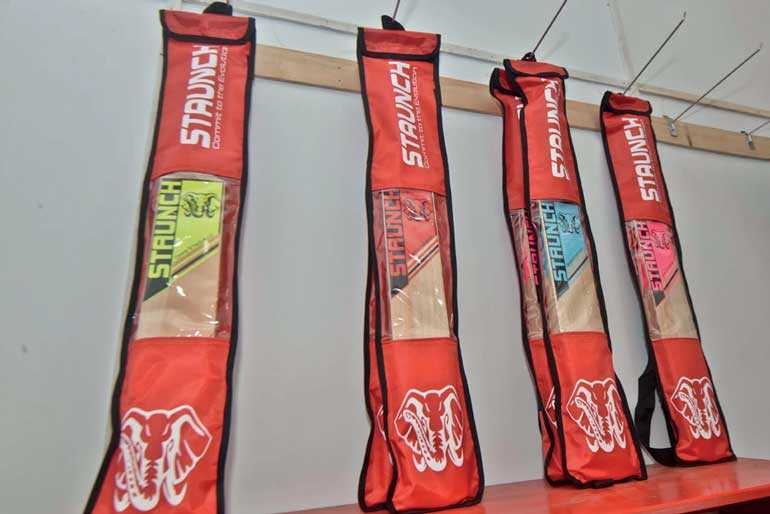
A range of Staunch bats

Staunch cricket gloves
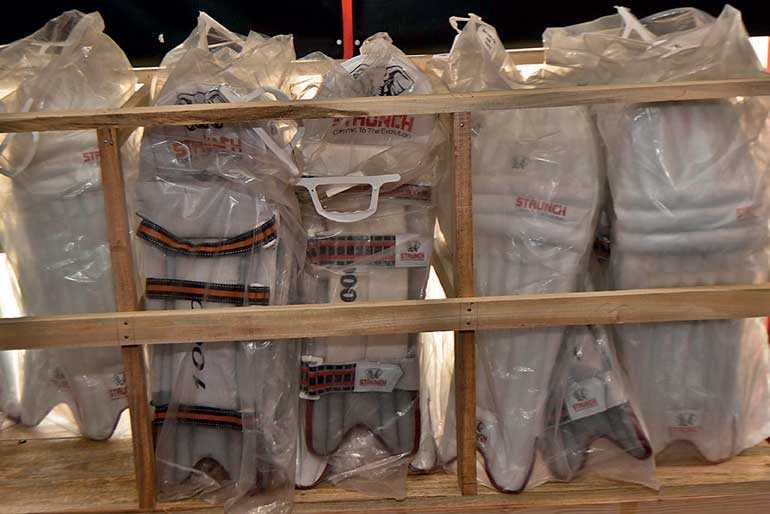
Staunch cricket pads
By Madushka Balasuriya
Cricket, now more than ever, is big business. So big in fact, that for Sahan Dikmadugodage not even going broke was enough to deter him from breaking into it.
It was late 2018 when his bank balance approached zero, and he was left with nothing more than Rs. 400 in hand and a seemingly broken dream. Earlier that year the then 22 year-old Sri Lankan had launched Staunch Bats, Sri Lanka’s first and so far only cricket bat manufacturing business. And so confident was Sahan in the idea that he found himself relocating to Sri Lanka from Australia, where he was born and raised.
“I moved to Sri Lanka in January 2018, and then in 2018 I was pretty much making the bats in my parents’ holiday house,” says Sahan.
Being a self-proclaimed cricket fanatic, the seeds for the idea were planted on a visit to Sri Lanka a year earlier, in the midst of a hunt for an authentic Sri Lanka Cricket jersey.
“In 2017 I came to Lanka on a holiday by myself. And one of the first things I did was go to find one of those Sri Lankan Dilmah Cricket jerseys. I had the fake ones, but I wanted an original replica. That was my favourite era and I just wanted a proper jersey to remind me of that era,” recalls Sahan.
“And then I went to these sports shops and in every shop I saw these bats going for 70,000 to 90,000. It was just too much. Because I knew all my Indian friends growing up, they would go to India and buy some bats for a cheaper price. Cos apparently in India it’s cheaper than bats in Australia. But here in Lanka, bats are more expensive than the bats in Australia.”
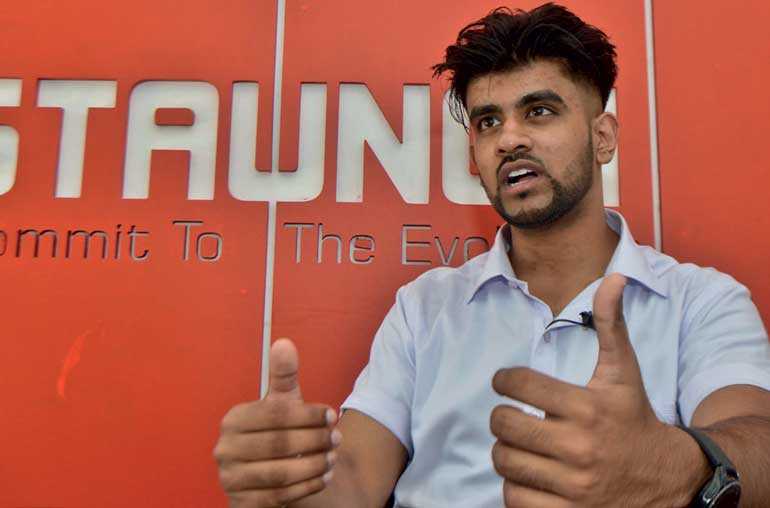
Founder Staunch Sahan Dikmadugodage
After this encounter, Sahan forgot all about the price of bats for a while, going back to university to work on his international business degree. But like all great ideas, inspiration came when least expected. For Sahan, fittingly it came to him while swinging a bat.
“I was in the back yard just swinging a bat, and it just hit me. I put two and two together and I knew I had to make cricket bats. I did some Google research, got my cousins in Sri Lanka to give me some research. And I pretty much found out that there were no bat manufacturers in Sri Lanka.”
Indeed, not only were there no bat manufacturers in Sri Lanka, but Sahan’s research showed that the ones who had entered the market early in other countries tended to be quite successful.
“There are bat manufacturers pretty much all over the world, in all the main cricket nations. India, Pakistan, Australia, England, New Zealand, South Africa, there’s bat makers there. In Australia there’s at least 20 smaller manufacturers, New Zealand there’s a handful as well, India there’s fair dozens – India it’s crazy, Pakistan it’s crazy. That’s pretty much the competition I’m up against,” explains Sahan.
“The first few bat manufacturers in Australia did really well. They managed to get their bats on the international scene in Australia, and it’s pretty much been the same with India, Pakistan – the first few companies in those countries did really well too. That’s a given fact.
“So when I found out that Sri Lanka didn’t have any bat manufacturers, I knew there was an opportunity. But I knew I had to do it right. Just because I did it first doesn’t mean that it’s going to be successful, I just had to do it right.”
All my Indian friends growing up, they would go to India and buy some bats for a cheaper price. Cos apparently in India it’s cheaper than bats in Australia. But here in Lanka, bats are more expensive than the bats in Australia. I was in the back yard just swinging the bat, and it just hit me... I knew I had to make cricket bats
A rebel with a cause
But doing it right meant thorough follow through on each and every step, though it also meant making a tough choice with regard to his higher education.
While Sahan was never a kid who placed a lot of value on the academic side of things – he readily admits that he “stuffed up” in high school, repeating Year 11 and 12 after getting suspended, and copping a lot of flak from the Sri Lankan community in Melbourne in the process (“If you stuff up over there it’s like Lanka, the aunties gather around and talk about you”) – he eventually got his act together, starting a diploma course where he would finish at the top of his class, a result that would see him accepted into Monash University.
At Monash too he was doing exceedingly well, while working part time at Melbourne Airport. It was during this period that Sahan really began to focus on making his bat manufacturing dream a reality, watching how-to videos on YouTube, making factory visits to several of Australia’s leading bat manufacturers, and essentially learning how the industry works.
“Every bat maker I visited, or method I learnt from YouTube, I picked out a specific thing – one thing that I felt was better than the other process. So my process now is completely different, it’s all taken from each bat maker,” he recalls.
“Not everyone makes it the same. Some tools and machines are taken from bat manufacturers, they’re all different. But I honestly feel like – and I’m not trying to up my ego or anything – but I think my one’s good because I pretty much went to at least five or six bat manufacturers in Australia, and then I just picked out the best practices.”
As such all of Sahan’s technical expertise has come ‘on the job,’ and while he says university gave him the foundation run a business, he insists a lot of it is common sense. After a few months of research and practicing how to make bats, by 2018 Sahan had decided to put his degree on hold and move to Sri Lanka. This was a decision that, understandably, didn’t go down well with his family. But Sahan was certain it was the right one.
“I always rebelled against stereotypes. When I started this idea back in 2017, everyone gave me a hard time. Back in Australia it’s very common to get a degree, get married, have kids, it’s very routine. “I knew I had an academic thing but I didn’t want to go along with for the sake of it. Business is pretty much self-explanatory. You don’t need a degree, it’s very common sense for business. Doctors, engineers, lawyers that’s different, but business is pretty much common sense. And when I was in uni it was pretty much common sense to me. The stuff I’m doin right now, university will never teach you. They don’t train you to pitch to investors, they don’t teach you that stuff. You learn that on the job.”
Harsh lessons
And so it came to be that Sahan packed up his bags and relocated to his family’s holiday home in Kotikawatta, a short drive away from Kelanimulla where he would set up Staunch’s manufacturing base. But that first year would end up being a steep learning curve.
“I was importing Kashmiri Willow from Pakistan back then, but the guy eventually shafted me. I lost about seven to eight lakhs. When I was practicing making the bats in Australia I was buying two to three at a time from him, but when I got here I placed a massive order for like 30 [Willow] clefts. Those never came to me.”
Midway through 2018, Sahan brought two more investors into the business to help him with marketing strategy. The move helped settle the ship so to speak, but it wasn’t enough. By December 2018 there would be no money left – not in the business, not personally.
“I had no choice but to go back. I didn’t have any money left, I had like Rs. 400 in my hand. I didn’t even have enough money to go back, my [younger] brother is the one who bought me the ticket back to Australia. I was malnourished, I was living pretty much on one meal a day.”
It’s at this point Sahan tells me about how comfortable his life was in Australia, prior to him upending everything to start a business in Sri Lanka. In a country where minimum wage affords an extremely comfortable lifestyle, it’s not uncommon to see kids fresh out of high school simply skip university altogether and simply work a regular day job to pay their way through life.
“I had a part time job back in Australia where I was earning a fair bit of money, I had a year left in my degree, I had a car, I had the life.”
For Sahan, his job at the Melbourne Airport meant he could afford a car, while having more than enough to spend on food and drinks and hanging out with his mates. So when he returned to Australia, after the failure of his business, his family and friends would have been forgiven for thinking that would be the end of it.
“I took a month off, I didn’t think about cricket for a month. I was just enjoying life, meeting friends.”
It was during this period that he had a chance meeting with Sri Lankan cricketer Suraj Randiv, who was impressed by Sahan’s vision for bat manufacturing in Sri Lanka. This interaction strengthened Sahan’s resolve. He proceeded to work part-time for the next six months, earning enough cash to buy better machinery and better equipment. By the second half of 2019, he had returned to Sri Lanka.
It was also during this period that he began working on gaining ICC (International Cricket Council) accreditation, something he knew would set his bats apart.
“Not every brand can be on the international stage, not every brand can make it on to ICC matches. There is a process that you have to go through, they check for copyrights, and whether you’re a legitimate manufacturer, whether you use legitimate willow, it’s a long process. It usually takes 12 months but when I got my application form, me and my other two business partners – they pretty much filled it out to me – we spent a good two to three months just filling the stuff, getting the right pictures, getting the right sources, invoices, everything in between.
“Then after you submit it, it usually takes a year, but we got it in three months for some reason, it was like fast-tracked.”
Setting Staunch apart
Staunch Bats are now comfortably within ICC regulations, but the 24 year-old also believes that his cricketing background – both as a fan, and an amateur player throughout his youth – has provided him with unique insight into what needs to go into making a well-rounded cricket bat.
“I honestly let my bat do the talking. The pick up, the feel, the balance. The thing is – and I’m not trying to shade other businesses – but they make 100 bats a day. They don’t have time to slow down and check every bat one by one. They don’t put 100%, they just quickly make it. They just get shipped around the world, there’s a brand image person over there, so people will buy the brand. You can have a crap bat, put some stickers on and people will buy it.” Staunch bats too have stickers, but they’re far more than simply decorative additions. While Sahan admits the aesthetic of a bat plays a big role in how players – mostly the younger ones - decide on which bat to purchase, he feels that there should be a little more to it. As he explains the methodology to me, it’s clear to see the passion Sahan has for the sport.
“If you take [Kumar] Sangakkara and Kusal Janith Perera, they’re completely different players. They’re both left handers but completely different. Those guys shouldn’t be using the same type of bat. Sanga is always on the drive, front foot forward, so the ball is always going to come lower to him. A person like Kusal is always on the back foot, hooking it and pulling it. So if you’re on the back foot the ball is always going to travel a bit higher, so that’s when you need the sweet spot a bit higher.
When I found out that Sri Lanka didn’t have any bat manufacturers, I knew there was an opportunity. But I knew I had to do it right. Just because I did it first doesn’t mean that it’s going to be successful, I just had to do it right
“When I make bats I have four models; 1000s are for the kids with a lower sweet spot for drivers; the 2000s are for the kids as well but with a higher sweet spot, so it’s for the hook. I don’t make the bats according to the stickers, I make the bats according to the styles.”
The four types of bats currently being sold by Staunch come in four colours, each representative of a particular style of play. Prices range from Rs. 9,000 for kids’ bats to Rs. 40,000 for Grade 1 bats. In between you have the Grade 3 and 2 bats going for Rs. 15,000 and Rs. 28,000 respectively.
As it stands, these prices are, according to Sahan, about half the price of similar English Willow bats available elsewhere in Sri Lanka. But he believes he can make them even more affordable if the Government follows through with promised tax concessions on his raw materials.
At present, Sahan imports the clefts, the handles, the grips, the stickers, the thread, and the toe guards, all of which are taxed heavily and not produced locally. It’s this tax barrier which makes it more affordable for other cricket bat retailers in the country to simply import bats than make them themselves.
Sahan’s research into the local industry and competition however has opened his eyes to the cutthroat nature of the business.
“So this is a problem I ran into when I came here. When I was making Kashmiri Willow bats, I went to cricket stores in Sri Lanka and those stores would tell me to take the Kashmir stickers off and put English Willow stickers on. There’s a game like that going on. Not many people can tell the difference. But those bats should be Rs. 3,000-4,000, instead they go for Rs. 10,000-15,000.
“If you look at the clefts there’s a certain colour of the tone. They’re usually lighter, and English Willow bats should be lighter than the Kashmir Willow. Performance wise the English Willow bounces a lot more because the sweet spot is higher, the Kashmir sweet spot is lower. It’s heavier and aesthetic wise Kashmiri is a bit darker. It’s very hard to spot unless you have a trained eye.”
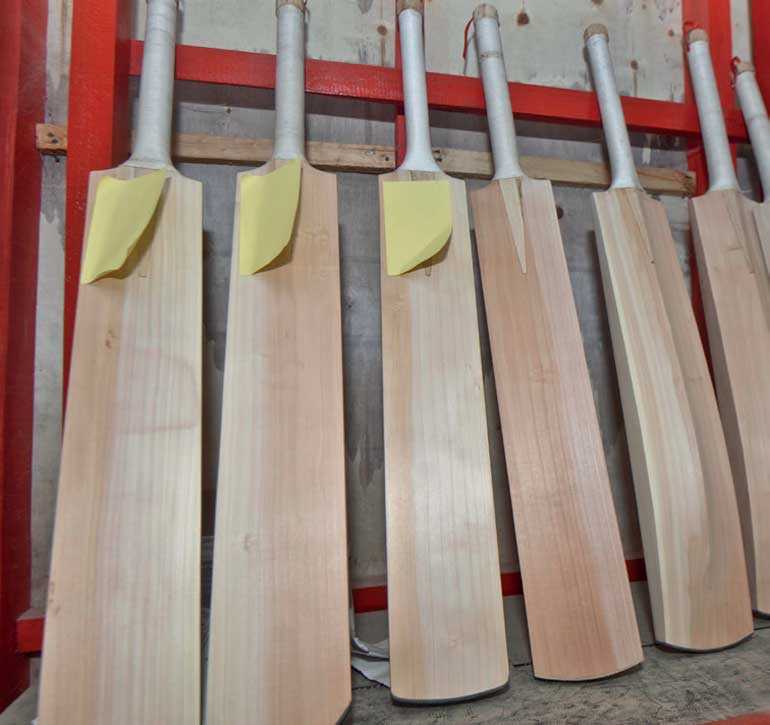
Staunch bats prior to being given the finishing touches
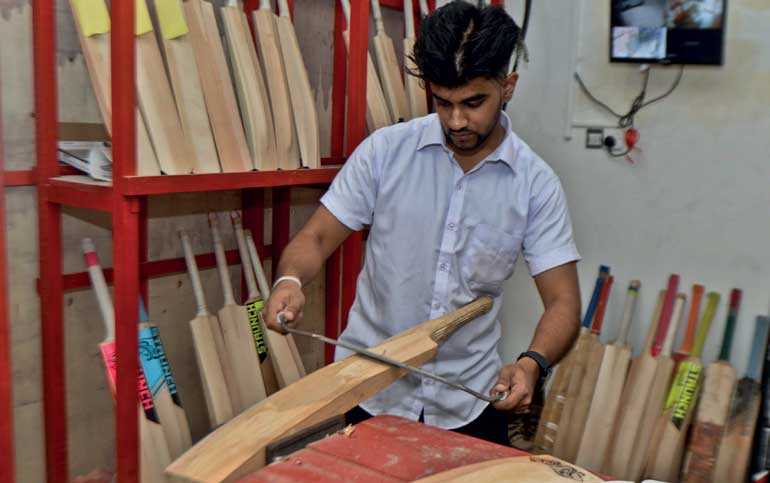
All the manufacturing work is done by Sahan and two other employees
What next?
By October 2019 Sahan had begun selling his bats, and now – before the COVID-19 pandemic brought the world to a halt – he says business has been picking. He currently produces about two to three bats a day, but his goal is to hit the 100 mark.
All this is also part of his own personal evolution, which is incidentally the thing which gave rise to Staunch’s slogan, ‘Commit to the Evolution’.
“I was working at Melbourne Airport and my work colleagues and I – the ground staff – our group was called Staunch. We were the Staunch crew, we were mates, we were baggage handlers. And when I was starting this company and I was thinking up names it just hit me, ‘I’ll just call it Staunch,’” he explains. “Because I like to have a bit of my past and everything.”
So what’s next on that evolutionary scale? Well, Sahan is already making cricket pads and gloves, but what he really has his sights set on his cricket ball manufacturing. While cricket bats are manufactured globally, cricket ball manufacturing is more of a closed shop.
There are three main manufacturers of cricket balls used in international matches: Kookaburra, Dukes and SG. The manufacturer of the red (or pink) balls used for Tests varies depending on location: India uses SG; England, Ireland and the West Indies use Dukes; and all other countries use Kookaburra.
“Why not Lanka?” asks Sahan rhetorically. “Those balls are made specific for those countries and those conditions, but there’s no ball that’s made specifically for Sri Lanka. The Indian and Lankan pitches are still completely different.”
Sahan hopes to start manufacturing cricket balls in December, and unsurprisingly he has already started researching it. But as with any ambitious young businessman, he’s not likely to be done there.
“And eventually I want to get into other sports. I can’t see why not. We are a manufacturing nation, we should be able to make this stuff easily.”
You can check out Staunch Bats on website lk.staunchsport.com.
Pix by Daminda
Harsha Perera